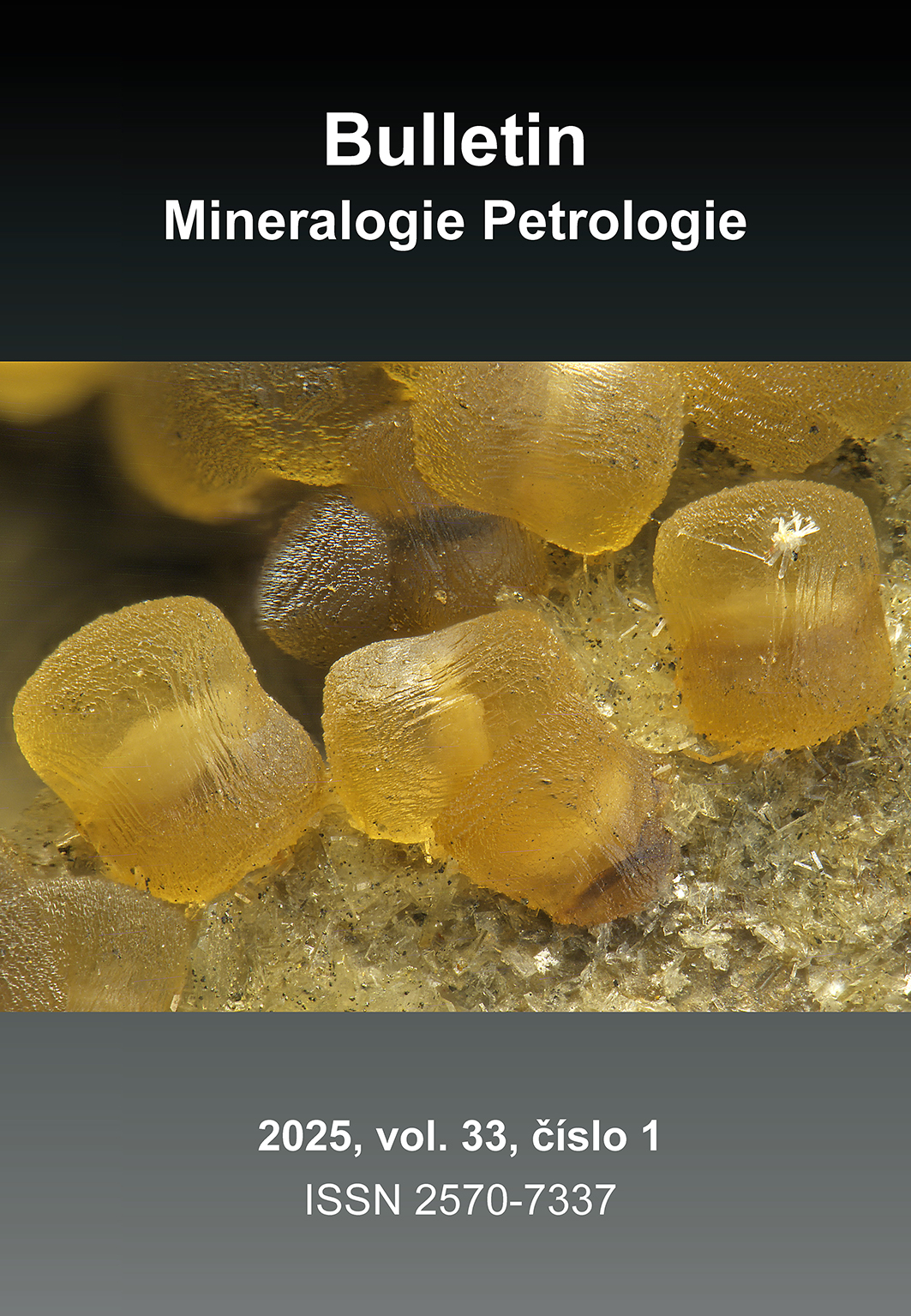Supergénne minerály zo štôlne Juraj, Hodruša-Hámre (Slovenská republika)
Supergene minerals from the Juraj adit, Hodruša-Hámre (Slovak Republic)
Klíčová slova
Abstrakt
An interesting supergene mineral association was identified at the abandoned Juraj adit near Hodruša-Hámre village, Štiavnické vrchy Mts., Slovak Republic. It is represented by allophane, anglesite, brochantite, calcite, cerussite, dundasite, gypsum, hydrozincite, linarite, malachite, posnjakite and zincowoodwardite. Anglesite occurs as well developed, colourless, tabular to prismatic crystals up to 3 mm in vugs of weathered galena-rich gangue. It is orthorhombic, space group Pnma, the unit-cell parameters refined from X-ray powder diffraction data are: a = 8.447(1), b = 5.3863(10), c = 6.9563(9) Å and V = 317.63(9) Å3. Cerussite is the most common supergene mineral and it forms colourless to white tabular, prismatic or acicular crystals up to 9 mm in size, which are often twinned and are associated together with dundasite, malachite and linarite in the cavities of gangue or mineralized rocks. The refined unit-cell parameters of cerussite from the powder X-ray diffraction data (for the orthorhombic space group Pmcn) are a = 5.174(1), b = 8.478(2), c = 6.135(1) Å with V = 269.1(1) Å3. Dundasite forms white or pale-blue, radial to spherical aggregates up to 1 mm, which are composed of well formed acicular crystals and cover areas up to 4 × 1.5 cm in cavities of ore gangue. Its refined unit-cell parameters from the powder X-ray diffraction data (for the orthorhombic space group Pbnm) are a = 9.071(2), b = 16.394(5), c = 5.618(2) Å and V = 835.4(5) Å3. Hydrozincite occurs as compact, white, up to 1 cm thick crusts or botryoidal aggregates on the adit walls together with calcite and zincowoodwardite. It is monoclinic, space group C2/m, the unit-cell parameters refined from X-ray powder diffraction data are: a = 13.63(2), b = 6.319(8), c = 5.397(9) Å, β = 95.9(3)° and V = 462(1) Å3. Linarite often forms well developed, bright blue, tabular to prismatic crystals up to 4 mm in size, which are often grouped to the radial aggregates and crystalline crusts in cavities and fractures of ore gangue (together with cerussite, dundasite and malachite) or on the walls of adit (associated with brochantite, gypsum, posnjakite and zincowoodwardite). Its refined unit-cell parameters from the powder X-ray diffraction data (for the monoclinic space group P21/m) are a = 9.691(3), b = 5.650(2), c = 4.686(2) Å, β = 102.68(2)° and V = 250.3(1) Å3. Rare posnjakite occurs as pale blue, acicular crystals up to 1 mm, which were observed on the adit walls associated together with brochantite, linarite and zincowoodwardite. The refined unit-cell parameters of posnjakite from the powder X-ray diffraction data (for the monoclinic space group Pm) are a = 10.569(14), b = 6.349(4), c = 7.857(9) Å, β = 117.94(7)° and V = 465.7(9) Å3. Zincowoodwardite was observed exclusively on the walls of adit as an white-blue to pale-blue crusts with botryoidal surface, which covers areas up to 5 × 4 cm. Associated minerals include brochantite, calcite, gypsum, hydrozincite, linarite and posnjakite. It is trigonal, space group P-3, the unit-cell parameters refined from X-ray powder diffraction data are: a = 3.057(9), c = 8.865(8) Å with V = 71.8(2) Å3. A newly described association of supergene minerals from the Juraj adit was formed as a sub-recent product of decomposition of primary sulfidic mineralization (mostly galena, sphalerite, chalcopyrite and pyrite) in the conditions of abandoned mine.
Soubory
Reference
Cocco G., Fanfani L., Nunzi A., Zanazzi P. F. (1972) The crystal structure of dundasite. Mineral. Mag. 38, 564-569.
Downs R. T. (2006) The RRUFF Project: an integrated study of the chemistry, crystallography, Raman and infrared spectroscopy of minerals. Program and Abstracts of the 19th General Meeting of the International Mineralogical Association in Kobe, Japan, O03-13.
Effenberger H. (1987) Crystal structure and chemical formula of schmiederite, Pb2Cu2(OH)4(SeO4). with a comparison to linarite PbCu(OH)2(SO4). Miner. Petrol. 36, 3-12.
Ghose S. (1964) The crystal structure of hydrozincite, Zn5(OH)6(CO3)2. Acta Crystallogr. 17, 1051-1057.
Chevrier G., Giester G., Heger G., Jarosch D., Wildner M., Zemann J. (1992) Neutron single-crystal refinement of cerussite, PbCO3, and comparison with other aragonite-type carbonates. Z. Kristallogr. 199, 67-74.
Kaňa R. (2013) Hodrušské hlbiny-Podzemný svet baníkov. 1-189, Banskoštiavnicko-hodrušský banícky spolok v Banskej Štiavnici, Banská Štiavnica.
Kaňa R., Čelko M., Mrákava F. (2011) Hodruša v zemi baníkov. 1-191, Banskoštiavnicko-hodrušský banícky spolok v Banskej Štiavnici, Banská Štiavnica.
Konečný V., Lexa J., Halouzka R., Dublan L., Šimon L., Stolár M., Nagy A., Polák M., Vozár J., Havrila M., Pristaš J. (1998) Geologická mapa Štiavnických vrchov a Pohronského Inovca. GS SR, Bratislava.
Laugier J., Bochu B. (2011) LMGP-Suite of Programs for the Interpretation of X-ray Experiments. http://www.ccp14.ac.uk/tutorial/lmgp.
Mellini M., Merlino S. (1979) Posnjakite: 2[Cu4(OH)6(H2O)O] octahedral sheets and its structure. Z. Kristallogr. 149, 249-257.
Onačila D., Rojkovičová Ľ., Žáková E., Repčok I., Eliáš K., Kalinaj M. (1993) Epitermálna žilná mineralizácia hodrušského rudného poľa-čiastková záverečná správa. MS, archív Geofond, Bratislava, 78747.
Tóth M. (1882) Magyarország ásványai különös tekintettel termőhelyeik megállapítására. 1-509, Hunyadi Mátyás, Budapest.
Witzke T., Raade G. (2000) Zincowoodwardite [Zn1-xAlx(OH)2][(SO4)x/2(H2O)n], a new mineral of hydrotalcite group. N. Jb. Mineral. Mh. 455-465.
Zepharovich V. (1859) Mineralogisches Lexicon für das Kaiserthum Österreich. Band I. 1-627, Wilhelm Braumüller, Wien.
Zipser Ch. A. (1817) Versuch eines topograhisch-mineralogischen Handbuches von Ungern. 1-440, Carl Friedrich Wigand, Oedenburg.
